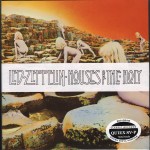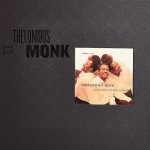 More of the Music of Thelonious Monk
More of the Music of Thelonious Monk
What a Good Copy of Brilliant Corners Sounds Like
During our most recent shootout of Brilliant Corners, we took the opportunity to play the Craft pressing cut by Bernie Grundman and released in 2023.
We thought it was godawful, the worst sounding version of the album we’ve ever played.
But how is that possible? Read all about the best practices being followed and look at the description of the fancy packaging below. Why would they go to all that trouble just to produce a bad souding record?
For the answer to that question, you will have to ask them. We’re stumped.
- Pressed using a one-step lacquer process at RTI utilizing Neotech’s VR900 compound
- All-analog mastering by Bernie Grundman from the original master tapes
- Housed in a foil-stamped, linen-wrapped slipcase
- Numbered and limited to 4,000
They used Neotech’s VR900 compound! Really?! That must be one awesome compound!
Apparently even the VR900 compound was not enough to save this pathetic excuse for a record.
For those of you who might be new to this blog, we should point out that we have been dumbfounded by Bernie Grundman’s work for more than twenty five years. The first RCA he remastered for Classic Records, LSC 1806, was so bright and the strings were so shrill that it probably lasted on our turntable maybe all of three minutes. My ears just couldn’t take it, even on a system that was dramatically darker and less revealing than the one we have now.
Equally bad sounding Classic Records were to follow by the hundreds.
Our quickie notes for side one can be seen below. After hearing side one fall so short of the mark, we dropped it from the shootout and put the Craft pressing on the shelf to go back to whoever loaned it to us. Who cares what side two sounds like if side one is that bad? Time is money. We are in the business of finding good records to sell to our customers, not playing crap Heavy Vinyl that only the most hard-of-hearing collector types would consider owning.
Before long we had a change of heart. We thought we owed it to Bernie’s fans to be more thorough, so we took our best side two and played it against the Craft pressing.
The scathing notes you see are the result of the emotions you might experience if you were forced to sit through an album whose sound has been completely screwed up. Keep in mind we brought this on ourselves. We volunteered for this duty.
And it was ruined not by some audiophile wannabe engineers making audiophile records. A guy like this has an excuse. He doesn’t know anything about making records.
No, this turd was made by someone who should know better than to turn in such shoddy work. It’s inarguable that Bernie Grundman used to make good sounding records. We know that for a fact because we’ve played them by the hundreds.
He apparently has lost whatever skill he previously possessed.
And it simply won’t do to deny it.
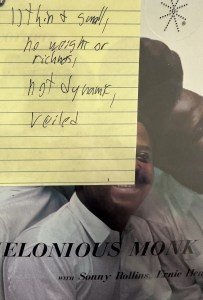
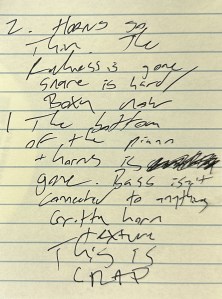
Our notes for side two, for those who have trouble reading our scratch:
- Horns so thin.
- The richness is gone.
- Snare is hard and boxy.
- The bottom of the piano and horns is gone.
- Bass isn’t connected to anything.
(When I asked our listening guy what he meant by this, he said all of the rich lower mids were gone and all that was left down there was blubbery deep bass. Robert Brook has quite a bit to say about that subject, well worth reading.)
- Gritty horn texture.
- This is CRAP!
At least one reviewer liked it a lot more than we did:
While the Neotech VR900 vinyl compound can sometimes sound soft, here it does not. but it surely is dead quiet. The quiet further expresses the skilled front to back layering in Jack Higgins’ live mix. The celeste Monk plays with his right hand while playing piano with his left definitely sounds best on this “One Step”. Likewise, Monk’s solo piano on “I Surrender Dear” has the most profound and pleasing sustain—though again, none of these editions are less than a seriously pleasant listen and each has its minor pleasing embellishments. Also, on “Bemsha Swing” from the second recording session, where the sound is quite different and Roach’s drum kit is pushed further back on the soundstage, the NeoTech VR900’s quiet (plus probably the “One Step” process), proves its worth. You really catch all of what Roach is doing.
My conclusion: other than the inexplicably poor cover art reproduction, this is a recording worthy of a “Small Batch” One-Step and Bernie Grundman did his usually great mastering job.
Hard to believe we played the same record. When it comes to Michael Fremer’s reviews, we say that a lot. All the time in fact. Possibly without exception. To be sure I would have to check my notes, and that’s more trouble than it’s worth.
More from Robert Brook
Robert Brook did a shootout using both his own and many of our killer copies and went into great detail about the time-consuming, somewhat exhausting experience and what he learned from it. We feel that the many insights he gained make his review one that audiophiles will find well worth reading.
If you want to make progress in this hobby, he’s the guy that can show you how to do it based solely on his personal experience.
Below you will find our reviews of the more than 200 Heavy Vinyl pressings we’ve played over the years.
(more…)

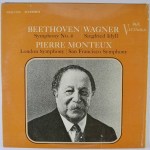 More of the music of Ludwig van Beethoven (1770-1827)
More of the music of Ludwig van Beethoven (1770-1827) At least the midrange is more or less correct.
At least the midrange is more or less correct. More of the Music of Thelonious Monk
More of the Music of Thelonious Monk




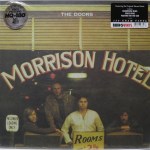 More of the Music of The Doors
More of the Music of The Doors Just listen to the vocals — they’re all wrong.
Just listen to the vocals — they’re all wrong. 
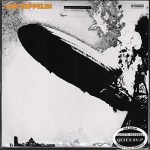 More of the Music of Led Zeppelin
More of the Music of Led Zeppelin